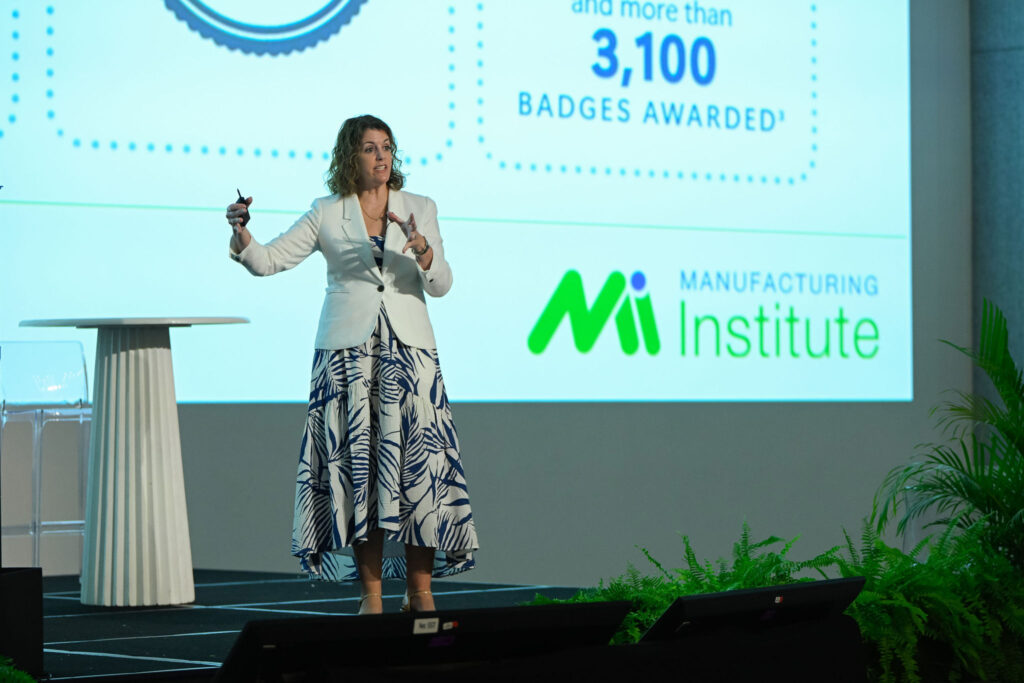
For all of our members and baker guests in attendance, one of the most valuable resources is their workforce. Recruiting and retaining a labor force was one of the most talked about topics at Convention. Carolyn Lee, President and Executive Director of the Manufacturing Institute shared ways to confront some of the workforce challenges the manufacturing sector is currently facing.
 Worker shortage
Worker shortage
Lee presented some startling facts about the state of the manufacturing workforce. The manufacturing sector has 381,000 open jobs, which is down from previous years. However, the ten-year outlook is that there will be nearly 4 million manufacturing jobs available.
“This most recent [talent] study is 3.8 million jobs will need to be filled,” she said. Half of them, 1.9 million, will go unfilled because we don’t have the people with the skills.”
Some of those jobs come from baby boomers retiring. Others will be at new manufacturing facilities currently under construction.
“Manufacturing construction is up,” Lee said. “Every time we saw one of these announcements, I sat there thinking, ‘Where are you going to get all these people?”
In addition to the boomer generation retiring, the generations that follow are certain to be smaller. Declining birth rates mean fewer available workers.
Upskilling
Finding warm bodies to fill the jobs isn’t enough anymore. Many manufacturing jobs require a specialized skill set to run complicated machinery. And everyone is looking to hire the same people.
“Manufacturers all across the US are facing the same challenge,” Lee said. “There are too few skilled people, and everyone’s fishing in the same pond.”
The solution, Lee said, is to invest in your workforce.
“We have to work together as an industry to build a sustainable and resilient workforce,” she said. “How do we do that? We need to first grow talent from within. The best person for that next open job is probably someone you have. They’re going to need more skills. They’re going to need more training. They’re going to need to understand why that skills and training is good for them and good for you, but you probably have that person.”
Investing in the next generation
In addition to more training for existing employees, it’s important to start engaging with the next generation of workers. That includes taking a proactive approach to your local educational institutions.
“You need to spend time with the boards of your local community and technical schools,” Lee said. “You need to share with them what you’re doing, how you’re doing it. Better yet, bring them into your plant and let them see what you make and why what you make is hard and cool and what the technology is that you use every day. Then talk to them about what the skills are that you need them to be training for.”
Manufacturers also need to help get the word out that manufacturing jobs can be high-paying without the cost of a college education.
“This isn’t the lesser than path, this is a competitive, in demand path, and we’re working on some economic data to help demonstrate to students and parents about the earning potential. One study showed that, after five years of graduation FAME (Federation for Advanced Manufacturing Education) graduates were making $95,000 a year.”
Second-chance hiring
Another potentially untapped talent pool is second-chance hires, people who may have trouble finding a job because of something in their past.
“Nearly one in four Americans had some exposure to the criminal justice system that has made it difficult for them to be able to get a good job,” Lee said.
Tapping into that second-chance community can be a win for everyone, but it does require extra support.
“For people who are coming out of the criminal justice system, they may have never had a job before right,” Lee said. “They may never have had to be someplace every day at a certain point in time. They may not know what to do when they’re sick.”
But if your company can provide that support, you and your second-chance hires can both benefit. Studies show that these hires have as high as an 80% retention rate as those employees remain loyal to the company that gave them a second chance.
Lee also encouraged manufacturers to place an emphasis on hiring more women and members of the armed service who are transitioning to civilian life.
Mentorship
Once you find employees, keeping them is another matter. Mentorship programs are one way to help new employees find their way and make them feel connected to your company.
“Employees who are mentored are better ready for promotions, stay with the organization longer, and are more likely to pay it forward,” Lee said. “They’re more likely to engage that next worker. And employees who mentor, they see that you, as a leader, are investing in them because you want them to be a mentor. They have higher job satisfaction, and they’re more willing to stay.”

